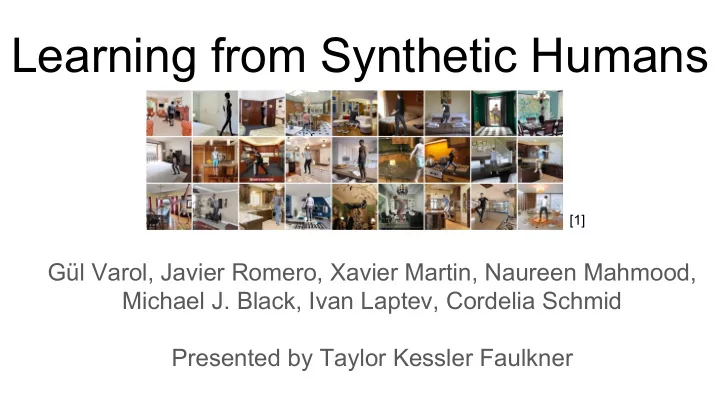

Learning from Synthetic Humans [1] Gül Varol, Javier Romero, Xavier Martin, Naureen Mahmood, Michael J. Black, Ivan Laptev, Cordelia Schmid Presented by Taylor Kessler Faulkner
Motivation ● CNNs can effectively learn 2D human poses ● Labeled real human data is expensive and difficult in large amounts ● Goal: create synthetic data that is not hand-annotated [1]
Goals ● Create a realistic synthetic dataset (SURREAL) ● Test whether a CNN can learn from SURREAL ○ Depth ○ Human parts segmentation ● Large synthetic person dataset with depth, segmentation, and ground truth [1]
SURREAL Creation ● Body model: SMPL ● Body shape, texture: CAESAR ● Body pose: CMU MoCap marker data ● Background: LSUN ● Ground truth: Blender ● Random: 3D pose, shape, texture, viewpoint, lighting, background image [1]
Network ● Adapted from 2D pose estimation ● Models spatial relations at different resolutions [1] ● Uses human body structure to obtain pixel-wise output [1] [2]
Depth and Segmentation ● Pixel-wise classification ● Segmentation: each pixel is classified ○ Head, torso, upper legs, lower legs, upper arms, lower arms, hands, feet, background ● Depth: Pelvis set as center ○ 9 depth levels in front, 9 levels behind [1]
Experimental Evaluation ● Segmentation evaluation ○ Intersection over union (IOU) ○ Pixel accuracy measures ● Depth estimation evaluation ○ Classification problem, but continuous values ○ Root-mean-squared-error (RMSE) b/w predicted and ground truth depth
[2] Slide taken from authors’ presentation
[2] Slide taken from authors’ presentation
[2] Slide taken from authors’ presentation
[2] Slide taken from authors’ presentation
[2] Slide taken from authors’ presentation
Video [4]
Strengths and Weaknesses ● Easy to create realistic synthetic images ● Provides a good pre-training dataset for real data ● Backgrounds are unrealistic ○ No interaction with lighting ○ Human movement around objects in background is wrong ● Groups of people cause problems, so we can only test on single humans
Extensions ● Addition of occlusions and groups of people in dataset ● Better interactions with background image ○ Also provides occlusion data (objects in background)
Citations [1] Learning from Synthetic Humans. G. Varol, J. Romero, X. Martin, N. Mahmood, M. Black, I. Laptev, C. Schmid. CVPR 2017. [2] G. Varol, J. Romero, X. Martin, N. Mahmood, M. Black, I. Laptev and C. Schmid, "Learning from Synthetic Humans", 2017. http://www.di.ens.fr/willow/research/surreal/varol_cvpr17_presentation.pdf [3] G. Varol, J. Romero, X. Martin, N. Mahmood, M. Black, I. Laptev and C. Schmid, [CVPR'17] SURREAL dataset - Learning from Synthetic Humans . 2017. [4] G. Varol, J. Romero, X. Martin, N. Mahmood, M. Black, I. Laptev and C. Schmid, [CVPR'17] SURREAL synthetic training results on Human3.6M. 2017. [5] G. Varol, J. Romero, X. Martin, N. Mahmood, M. Black, I. Laptev and C. Schmid, [CVPR'17] SURREAL synthetic training results on Youtube Pose
[5]
Recommend
More recommend